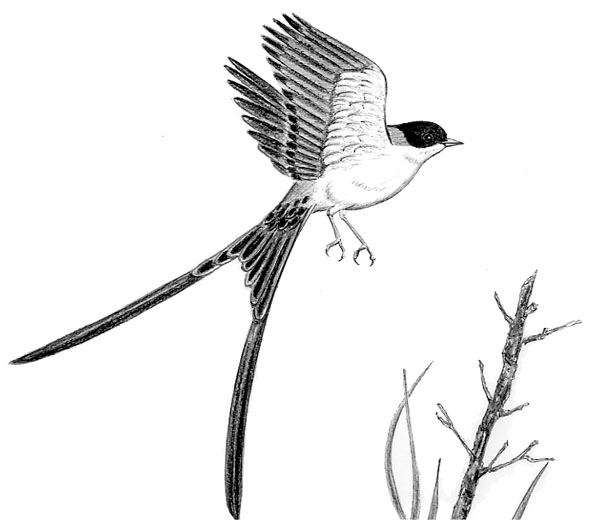
Dear Bird Folks,
This past Monday morning I was biking along the back roads of Wellfleet when I came upon group of weirdos with binoculars who were looking at a bird perched on the power lines. Not wanting to be seen with a group of bird nerds I continued on my bike ride without stopping. Now I’m curious as to what bird would cause so many bird freaks to line up and stare at the power lines on a Monday morning. Is there a rare bird around? Also, don’t these people have jobs?
– Bill, Newport, RI
Hold on, Biker Boy Billy,
My aunt is from Ireland and she quite often makes funny wisecracks about her Irish heritage. However, you don’t want to be in the same room with her if someone else cracks wise about the Emerald Isle. (Take it from me, shillelaghs hurt.) The same scenario applies to any group, including bird watchers. Birders may put up with being referred to as “weirdos” from other birders, but that doesn’t mean it’s okay for someone else to trash them, especially someone who rides around town on a bicycle. (By the way, have you seen those biking outfits?) As far as these people “having jobs,” why weren’t you at work on a Monday morning? Just wondering.
he bird that caught the attention of so many birders last week was a Forked-tailed Flycatcher. When most casual bird watchers hear the word “flycatcher,” they have all they can do to even fake an interest it. That’s because many flycatchers are dull and confusingly similar. But the fork-tail is not one of those birds. With its gray back, bright-white belly and black head-cap, it is both distinctive and striking. Then there is the tail. This phoebe-sized bird has black tail feathers that may reach 10″ long trailing behind it, looking like those fancy tuxedo tails worn by a concert pianist. (You can make joke here if you want, but not me.)
The purpose of these long tails is not clear. Usually such adornments are associated with breeding, and perhaps they do have something to do with mate attraction. The male flycatchers have slightly longer tails but the female birds have long tails too, and they both have them year-round, not just during the breeding season. The most likely reason for those extra-long tails is flight control and maneuverability. After all, they are flycatchers and it can’t be easy catching flies out of the air without a little extra help. However, there are well over 400 different species of flycatchers in the world and only a few of them have these excessively long tails. If long tails were the key to catching flies it would make sense for all 400 of the other flycatchers to have them too, and yet they don’t. So, who knows? Maybe they are there just to look cool, and there is nothing wrong with that.
As we move on from this fascinating tail talk, we are faced with yet another mystery. Fork-tailed Flycatchers are rare in the U.S. They are usually found in Central and South America. In fact, it’s quite possible that the bird we are talking about was born 5,000 miles away in Argentina or one of those similar countries. So why is it in Wellfleet? Many birds in the southern part of South America have a “reverse” migration; at least it’s reverse from what our birds usually do. As the weather gets colder in the south, some birds fly north toward their wintering grounds in the tropics. Every once in a while one of these flycatchers decides it’s not in the mood for the tropics and totally overshoots the wintering grounds, where it can end up just about anywhere. Other times a bird will make it to the wintering grounds okay, but come springtime it can’t figure out how to get back home. Instead of heading south the confused bird heads north, towards the good old USA. And when it arrives here it is instantly mobbed by dozens of freaky bird watchers. (Remember, it’s okay when I say it.)
The Fork-tailed Flycatcher that visited Wellfleet last week simply got its north and south mixed up. Either that or it made the same mistake I did and bought a used GPS from my brother-in-law. Bad idea. Whatever the reason, instead of heading toward its summer home this bird might end up experiencing a New England winter firsthand. That’s not a good thing for a flycatcher. Fortunately, this flycatcher also eats fruit and berries, including that nasty bitter sweet. My guess is it won’t have to live on fruit for long; typically these lost birds figure out their mistake and eventually start working their way back home. I’m not 100% sure if that will happen, but I didn’t want to end on a downer.
Speaking of lost birds, many people are still asking when to bring their hummingbird feeders in. That should have already happened by now. Most hummers are out of New England by the end of September. However, if you are still seeing hummingbirds, you should not only continue to leave your feeder out but get a picture of the bird. Late hummers are often rare lost visitors from other parts of the country and good photos will help with identification. If you don’t have a camera, you could borrow or buy one, but just don’t buy it from my brother-in-law.